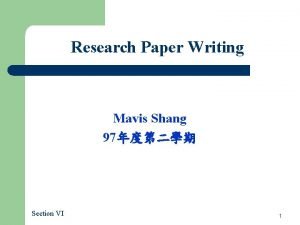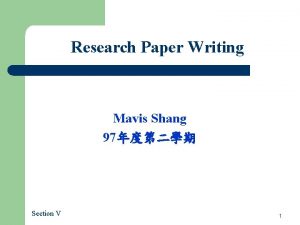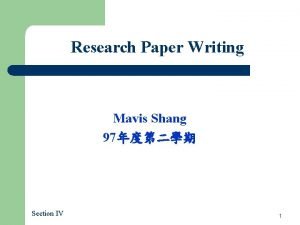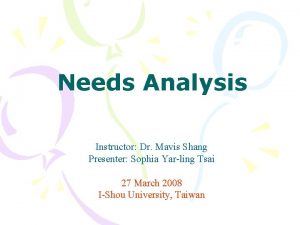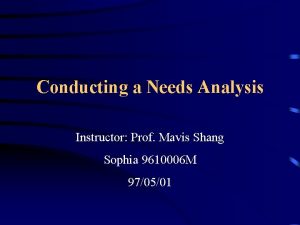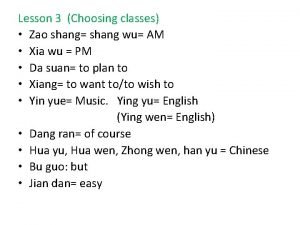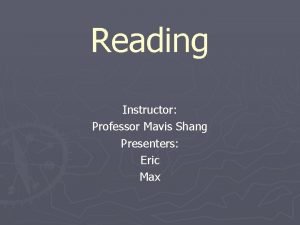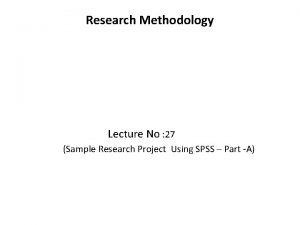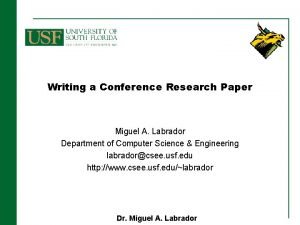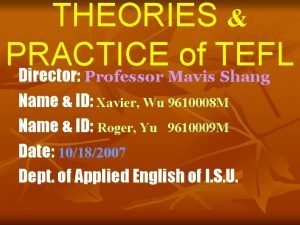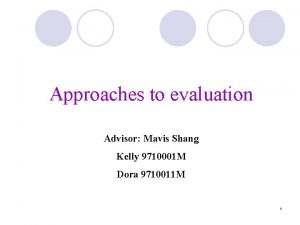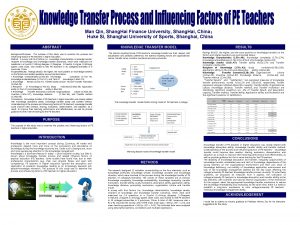Research Paper Writing Mavis Shang 97 Section V
























- Slides: 24

Research Paper Writing Mavis Shang 97年度第二學期 Section V 1

Sampling I. Definition: Select a given number of people from a population II. A. Probability sampling: Every member of the population has a possibility of being selected I. B. Nonprobability (purposeful) sampling: Select members who had the particular experience before; try to look for negative cases for better improvement 2

Sampling II. External Validity: Generalizability or Transferability A. Generalize findings to the larger (target) population, so need to provide detailed description of the case III. Sampling Strategies: A. Probability sampling B. Nonprobability (Purposeful) sampling C. Convenience sampling 3

Sampling A. Probability sampling: B. 1. Simple random sampling C. 2. Systematic sampling D. 3. Stratified sampling E. 4. Cluster sampling F. 5. Multistage sampling 4

Sampling 1. Simple random sampling: Each member has a number (code) and each population has an equal chance to be selected →Pro: simple process →Con: difficult to get a complete list of all populations; may include some “outsiders” 5

Sampling 2. Systematic sampling: Select every nth name from the list; so need to estimate the needed sample size →Pro: not every member needs to be numbered →Con: bias if members are arranged in a specific pattern (e. g. , choose the last name with A in the given year) 6

Sampling 3. Stratified sampling: Divide the populations into subgroups (e. g. , genders) or levels (e. g. , proficiency levels) and then draw randomly from each subgroup →Pro: easy to compare each subgroup results →Con: must get information before dividing them 7

Sampling 4. Cluster sampling: Choose groups of individuals e. g. , city blocks or classrooms in a school, and study all of the samples there →Pro: save time and money by collecting data at a limited number of sites →Con: small sample size, so less precision in estimating the effect 8

Sampling 5. Multistage sampling: Combine sampling strategies e. g. , use cluster sampling to randomly select classrooms and use random sampling to select a sample with each classroom →Pro: more reliable →Con: complex calculations (regression analysis) 9

Sampling B. Nonprobability (Purposeful) sampling: Provide in-depth, interpretive information 1. Extreme or deviant cases 2. Intensity sampling 3. Maximum-variation sampling 4. Homogeneous sampling 5. Typical-case sampling 6. Stratified purposeful sampling 10

Sampling 7. Critical-case sampling 8. Snowball or chain sampling 9. Criterion sampling 10. Theory-based or operational construct sampling 11. Confirming and disconfirming cases 12. Opportunistic sampling 13. Purposeful random sampling 14. Sampling politically important cases 11

Sampling 1. Extreme or deviant cases: Study the extreme (unusual) case to illuminate the ordinary e. g. , analyze an extremely best writer’s work and compare it with the poorest one 2. Intensity sampling: Similar to extreme cases, but less emphasis on extreme; explore rich information on typical cases; analyze why individuals meet the specified criterion 12

Sampling 3. Maximum-variation sampling: Maximize the variation within the samples and then indicate their unique (major) difference e. g. , study students’ English abilities among different locations (rural, urban, and suburban areas) 4. Homogeneous sampling: Identify the samples who share similar characteristics e. g. , rural teachers’ attitudes toward bilingual learning for kindergarten kids 13

Sampling 5. Typical-case sampling: Choose a case in which a program/instruction has been implemented to show this case is indeed average 6. Stratified purposeful sampling: Divide samples into subgroups and then select cases within each subgroup 7. Critical-case sampling: Study a very important, critical case and the effect should be representative: “if it happens there, it will happen anywhere. ” 14

Sampling 8. Snowball or chain sampling: Start with a key person and introduces the next one to become a chain 9. Criterion sampling: Set up a criterion and identify cases that meet that criterion e. g. , study cases that could pass TOEFL last semester 10. Theory-based or operational construct sampling: Define a theoretical construct (e. g. , metacognitive learning on EFL reading development) 15

Sampling 11. Confirming and disconfirming cases: Form grounded theory by analyzing sample cases that fit (confirming) and do not fit (disconfirming) the major points in literature 12. Opportunistic sampling: Should take the opportunity to decide the sampling procedure or samples during the study 16

Sampling 13. Purposeful random sampling: Randomly select participants who had similar experiences in a very small sample 14. Sampling politically important cases: Use particular samples that someone expects to use the results 17

Sampling Overall strengths and weaknesses of purposeful sampling: Pro: 1. Less costly and time consuming 2. Ease of administration 3. Assures high participation rate 4. Generalization possible to similar subjects 5. Assures receipt of needed information Con: 1. Difficult to generalize to other subjects 2. Less representative of an identified population 3. Greater subject bias 18

Sampling C. Convenience sampling: Choose the samples who are very available (easy to access), but can not generalize the results beyond the population poor Pro: 1. Less costly and time consuming 2. Ease of administration 3. Assures high participation rate 4. Generalization possible to similar subjects Con: 1. Difficult to generalize to other subjects 2. Less representative of an identified population 3. Greater subject bias 19

Sampling IV. Access Issues: Consider how to obtain your participants A. Get permission and agreement with the appropriate person (e. g. , school principal, classroom teacher, or parents) B. Obtain consent form from the participants C. How to “label” students if using stratified sampling D. Consider appropriate sample size 20

Sampling V. Sample size: A. Quantitative research rules: For survey research, 100 cases (see page 327) B. Qualitative research rules: For grounded theory, 30 -50 interviews (see page 328) 21

Sampling VI. Consent form (see page 336): A. Explain research purpose, duration, and procedures B. Describe any risk or discomfort C. Describe confidentiality or anonymity D. Provide the name of person to contact with E. Provide voluntary participation, and available to refuse or withdraw any time 22

Dear Principle of I-Shou International School, My name is Chiau-jen Zhu, and I’m a junior student of the Applied English Department at I-Shou University. In order to accomplish my required research, “The Effect of Reading Stories to Improve Elementary School Students’ Reading Ability”, I need your permission to interview students at your school. Reading stories has become a tendency to improve elementary school students’ reading ability. Therefore, my purpose is to interview students to get more ideas about the effect of reading literature. The interview includes three parts: past experience, the details of experience and personal opinions of participants. The participation is not compulsory, but I will appreciate your contribution if you agree with the interviews. Each interview will take 15 to 25 minutes, and five students are needed from the fifth to the sixth grade. In addition, the names of participants will be innominate for sure. As for the contents of interviews, the response will be summarized, and the raw data will not be presented in the final report. Besides, the participants have the rights to read and withdraw any time. The results of this study will be provided to my teachers and supervisors only, which will be very useful for their teaching. Thank you for your assistance in this study. Sincerely yours, Chiau-jen Zhu Junior, Applied English Department I-Shou University E-mail: gekkoh-159@yahoo. com. tw 23

Dear Friend: I am a junior student of Applied English Department at I-Shou University. My name is I-Ching Ko. I am working on a research paper now, and my topic is the effects of note-taking for EFL students’ listening comprehension. Therefore, I sincerely hope that you could do me a favor. I am going to ask you to talk about your past, present experiences, and personal opinions of taking notes while listening. It will take you only 15 to 20 minutes. In order to achieve the goal of accuracy, all your responses will be recorded. However, when I finish my research paper, all tapes must be destroyed. If there are some sensitive questions, you have the right not to answer it. If you feel uncomfortable, you can withdraw from this interview process anytime. Your responses are very important to the accuracy of my research. Therefore, please make your responses candidly. Of course your personal information won’t be identified in any way, and your name will be replaced by a number. In addition, all your responses will be kept confidential. Only Summarized data and results will be available. The results will only be provided to my teacher and other scholars who are interested in this field. Thank you for your contribution to the study. Sincerely yours, I-Ching Ko 24
 Mavis shang
Mavis shang Mavis shang
Mavis shang Mavis shang
Mavis shang Mavis shang
Mavis shang Content based syllabus example
Content based syllabus example Mavis shang
Mavis shang Zao shang hao zhong guo
Zao shang hao zhong guo Mavis chung
Mavis chung Mavis hara
Mavis hara Nolo nolle nolui
Nolo nolle nolui Mavis 500s
Mavis 500s Eric mavis
Eric mavis Achievements of the shang dynasty
Achievements of the shang dynasty Sample theoretical background
Sample theoretical background Ocjs grants
Ocjs grants Example of participants section in research paper
Example of participants section in research paper Example of methodology section of research paper
Example of methodology section of research paper Research gap example
Research gap example Miguel is writing a research paper
Miguel is writing a research paper Purpose of writing a research paper
Purpose of writing a research paper Tuesdays with morrie hibiscus plant
Tuesdays with morrie hibiscus plant English general paper paper 2 comprehension
English general paper paper 2 comprehension Aice general paper essay example
Aice general paper essay example Huang he map
Huang he map Chinese dynasty acrostic poem
Chinese dynasty acrostic poem
